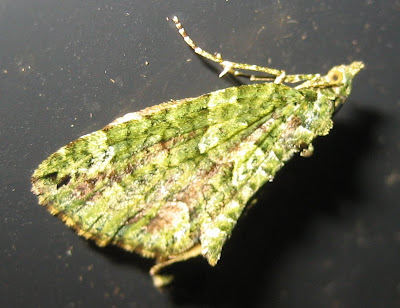
There is a moth called the Pod Lover, albeit never seen by me. Now I nominate this overnight visitor (above) as the Art Lover, because it had the nous to settle on this copy of an oil painting when I decanted the eggboxes in our kitchen, safe from the rain. It's a distinguished portrait because the painter was Nick Penny, now head of the National Gallery. We were schoolboys together in Shrewsbury where an exhibition including this picture opens next week. The subject is another of our 17-year-old contemporaries, Ron Smith, who was a talented and original artist like Nick. I didn't know him well and long ago lost touch, but the expression is how I recall him; an outsider and never seeming quite at ease.
The exhibition is launched on 9 October at Shrewsbury School's art building; I'm not entirely sure how generally open it is, but in my day the place welcomed all and sundry, as indeed it should, given its wonderful facilities and grounds, in which we frolicked happily all those years ago. One of those involved is John Alford, a fine painter himself who with Arthur Broadbent, a wonderful Irishman with a past career in wartime camouflage, ran an inspirational art department in the 1960s. Quite apart from their teaching, including Arthur's slides of outstanding European buildings which were almost all obscured by his Morris Traveller, their art school was a sort of independent republic. A basement window was never locked and much-used to escape Cadet Force and similar nonsense. I cannot prove that this negligence was deliberate but have no doubts myself.
And the moth? I'm pretty sure that it's a Common Quaker
(but see PS below). Less distinguished than its lined relations in the previous post, but trim. Its main flight season is March-May but small numbers emerge in mild autumns, and it's mild now (though soaking). Talking of which, I surprised this vast amphibian (below) outside our back door while setting the trap. It's toadlike in size but froglike in shape. Could it be a late, mild autumn pregnancy? Another question: why on earth have we got the hosepipe out in current conditions? I haven't the slightest idea.
 PS Dean has put me right in Comments. It's a Yellow-lined Quaker after all. Sorry.
PS Dean has put me right in Comments. It's a Yellow-lined Quaker after all. Sorry.

 Right, we really will stop now. The weather has chilled again and the mornings are getting dark. I'll leave you for 2010 with this fine Angle Shades which came the other night in spite of rain. It found a dry perch underneath the trap's plastic collar and was snoozing undisturbed when I braved the drizzle. Also there was the moth below, providing a textbook Laura Ashley example of how much slip to show (short enough to be interesting, etc). It's a November Moth, which seems a suitably seasonal note on which to conclude. I'm umming and erring about doing a monthly trap over the winter, just to see if anything is about. There is, for example, a handsome insect called the December Moth which I remember catching at our porch light in Leeds when I was a boy. But otherwise, see you in April, and many, many thanks for all the interesting and helpful comments.
Right, we really will stop now. The weather has chilled again and the mornings are getting dark. I'll leave you for 2010 with this fine Angle Shades which came the other night in spite of rain. It found a dry perch underneath the trap's plastic collar and was snoozing undisturbed when I braved the drizzle. Also there was the moth below, providing a textbook Laura Ashley example of how much slip to show (short enough to be interesting, etc). It's a November Moth, which seems a suitably seasonal note on which to conclude. I'm umming and erring about doing a monthly trap over the winter, just to see if anything is about. There is, for example, a handsome insect called the December Moth which I remember catching at our porch light in Leeds when I was a boy. But otherwise, see you in April, and many, many thanks for all the interesting and helpful comments.




























